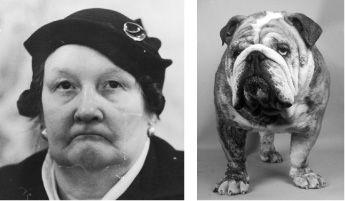The Definitive Book of Body Language (14 page)
Read The Definitive Book of Body Language Online
Authors: Barbara Pease,Allan Pease

Robert Provine, professor of psychology at the University of Maryland, Baltimore, found that human laughter is different from that of our primate cousins. Chimpanzee laughter sounds like panting, with only one sound made per outward or inward breath. It's this one-to-one ratio between breath cycle and vocalization that makes it impossible for most primates to speak. When humans began walking upright, it freed the upper body from weight-bearing functions and allowed better breath control. As a result, humans can chop an exhalation and modulate it to produce language and laughter. Chimps can have linguistic concepts, but they can't physically make the sounds of language. Because we walk upright, humans have a huge range of freedom in the sounds we make, including speech and laughter.
Laughter stimulates the body's natural painkillers and “feel good” enhancers, known as endorphins, helping relieve stress and heal the body. When Norman Cousins was diagnosed with the debilitating illness ankylospondylitis, the doctors told him they could no longer help him and that he would live in excruciating pain before he died. Cousins checked into a hotel room and rented every funny movie he could find: the Marx Brothers,
Airplane, The Three Stooges
, etc. He watched and re-watched them over and over, laughing as hard and loud as he could. After six months of this self-inflicted laughter therapy, the doctors were amazed to find that his illness had been completely cured—the disease was gone! This amazing outcome led to the publishing of Cousins's book
Anatomy of an Illness
, and the start of massive research into the function of endorphins. Endorphins are chemicals released from the brain when you laugh. They have a similar chemical composition to morphine and heroin and have a tranquilizing effect on the body, while building the immune system. This explains why happy
people rarely get sick and miserable but complaining people often seem to be ill.
Laughter and crying are closely linked from a psychological and physiological standpoint. Think of the last time someone told you a joke that made you buckle up with laughter and you could hardly control yourself. How did you feel afterward? You felt a tingling sensation all over, right? Your brain released endorphins into your system that gave you what was once described as a “natural high” and is the same experience that drug addicts get when they take dope. People who have trouble with laughing at the tough things in life often turn to drugs and alcohol to achieve the same feeling that endorphin-induced laughter produces. Alcohol loosens inhibitions and lets people laugh more, which releases endorphins. This is why most well-adjusted people laugh more when they drink alcohol, while unhappy people become even more despondent or even violent.
People drink alcohol and take drugs to try to feel
how happy people feel normally.
Paul Ekman found that one of the reasons we are attracted to smiling and laughing faces is because they can actually affect our autonomic nervous system. We smile when we see a smiling face and this releases endorphins into our system. If you are surrounded by miserable, unhappy people, you are also likely to mirror their expressions and become morose or depressed.
Working in an unhappy environment is
detrimental to your health.
The basis of most jokes is that, at the punch line, something disastrous or painful happens to someone. In effect, the unexpected ending “frightens” our brain, and we laugh with sounds similar to a chimp warning others of imminent danger. Even though we consciously know that the joke is not a
real
event, our laugh releases endorphins for self-anesthesis as if the joke is a real event. If it
is
a real event, we may go into crying mode and the body would also release its endorphins. Crying is often an extension of a laughing bout and is why, in a serious emotional crisis, such as hearing about a death, a person who cannot mentally accept the death may begin laughing. When the reality hits, the laughter turns to crying.

The origin of human laughter is as a
primate warning signal
In the 1980's, several American hospitals introduced the concept of the “Laughter Room.” Based on Norman Cousins's experiences
and other laughter research by Dr. Patch Adams, they allocated a room and filled it with joke books, comedy films, and humorous tapes, and had regular visits from comedians and clowns. Patients were then exposed to thirty- to sixty-minute sessions each day. The result was impressive—a dramatic improvement in patient health and shorter average hospitalization time per patient. The Laughter Rooms also showed a decrease in the number of painkillers required by those in pain, and patients became easier to deal with. So you could say that the medical profession now takes their laughter seriously.
He who laughs, lasts.
Robert Provine found that laughing was more than thirty times as likely to occur in participants in a social situation than in a solitary setting. Laughter, he found, has less to do with jokes and funny stories and more to do with building relationships. He found that only 15 percent of our laughter has to do with jokes. In Provine's studies, participants were more likely to speak to themselves when alone than they were to laugh. Participants were videotaped watching a humorous video clip in three different situations: alone, with a same-sex stranger, and with a same-sex friend.
Only 15 percent of our laughter has to do with
jokes. Laughter has more to do with bonding.
Even though no differences existed between how funny the participants felt the video clip was, those who watched the amusing video clips alone laughed significantly less than did those who watched the video clip with another person present,
whether it was a friend or a stranger. The frequency and time spent laughing were significantly greater in both situations involving another person than when the participant was alone. Laughter occurred much more frequently during social interaction. These results demonstrate that the more social a situation is, the more often people will laugh and the longer each laugh will last.
Karen Machleit, professor of marketing at the University of Cincinnati's College of Business Administration, found that adding humor to advertisements increases sales. She found that humor makes it more likely that consumers will accept an advertiser's claims and increases source credibility, so that a funny ad with a famous person becomes even more readily accepted.
The opposite to pulling up the corners of the mouth to show happiness is pulling both corners downward to show the Down-Mouth expression. This is done by the person who feels unhappy, despondent, depressed, angry, or tense. Unfortunately, if a person holds these negative emotions throughout their lifetime, the corners of the mouth will set into a permanent down position.
In later life, this can give a person an appearance similar to a bulldog. Studies show that we stand farther away from people who have this expression, give them less eye contact, and avoid them when they are walking toward us. If you discover that the Down-Mouth has crept into your repertoire, practice smiling regularly, which will not only help you avoid looking like an angry canine in later life, but will make you feel more positive. It will also help you avoid frightening little children and being thought of as a grumpy old cow.

The Down-Mouth expression can become a permanent facial
feature. Our intuition tells us to stay away from those
with a Down-Mouth expression
Research by Marvin Hecht and Marianne La France from Boston University has revealed how subordinate people smile more in the presence of dominant and superior people, in both friendly and unfriendly situations, whereas superior people will smile only around subordinate people in friendly situations.
This research shows that women smile far more than men in both social and business situations, which can make a woman appear to be subordinate or weak in an encounter with unsmiling men. Some people claim that women's extra smiling is the result of women historically being placed by men into subordinate roles, but other research shows that by the age of eight weeks, baby girls smile far more than baby boys, so it's probably inborn as opposed to learned. The likely explanation is that smiling fits neatly into women's evolutionary role as pacifiers and nurturers. It doesn't mean a woman can't be as authoritative as a man; but the extra smiling can make her look less authoritative.
Women's extra smiling is probably
hardwired into the brain.
Social psychologist Dr. Nancy Henley, at UCLA, described a woman's smile as “her badge of appeasement” and it is often used to placate a more powerful male. Her research showed that, in social encounters, women smile 87 percent of the time versus 67 percent for men, and that women are 26 percent more likely to return smiles from the opposite sex. An experiment using fifteen photographs of women showing happy, sad, and neutral faces were rated for attractiveness by 257 respondents. The women with the sad expressions were considered the least attractive. Pictures of unsmiling women were decoded as a sign of unhappiness, while pictures of unsmiling men were seen as a sign of dominance. The lessons here are for women to smile less when dealing with dominant men in business or to mirror the amount of smiling that men do. And if men want to be more persuasive with women, they need to smile more in all contexts.
Robert Provine found that in courtship, it's also women who do most of the laughing and smiling, not men. Laughing in these contexts is used as a way of determining how successfully a couple is likely to bond in a relationship. Simply put, the more he can make her laugh, the more attractive she will find him. This is because the ability to make others laugh is perceived as a dominant trait and women prefer dominant males, while males prefer subordinate females. Provine also found that a subordinate person will laugh to appease a superior person and the superior person will make subordinates laugh—but without laughing himself—as a way of maintaining his superiority.
Studies show that women laugh at men they're attracted to,
and men are attracted to women who laugh at them.
This explains why having a sense of humor is near the top of women's priority list of what they look for in a man. When a woman says, “He's such a funny guy—we spent the whole night laughing together,” she usually means that
she
spent the night laughing and he spent the night
making
her laugh.
From a man's perspective, saying that a
woman has a good sense of humor doesn't mean
she tells jokes; it means she laughs at
his
jokes.
On a deeper level, men seem to understand the attraction value of being humorous and spend much of their time with other men competing to tell the best joke to enhance their own status. Many men also become annoyed when one man dominates the joke-telling, especially when women are present and are also laughing. Men are likely to think the joke-teller is not only a jerk but he isn't particularly funny, either, come to think of it— despite the fact he has all the women in fits of laughter. The point for men to understand is that humorous men look more attractive to most women. Fortunately, you can learn to be humorous.